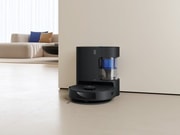Innovative lady makes a SOPHISTICATED table with similar designs priced at $1800 – but it only cost her $100!
- Replies 2
Upcycling is one of our personal favourite trends to come about from social media. The idea of taking something that would normally be considered garbage and turning it into something new and useful never fails to impress. It's a great way to save money, be creative, and reduce your impact on the environment.
Well, one creative Bunnings shopper decided to do just that. Jaharn Quinn had been meaning to DIY a plaster coffee table for months after scoring a glass panel from her local tip shop for $10.
“I started this upcycle six months ago when I found a gorgeous coffee table at my local tip shop and fell in love with the chocolate glass top, which I was able to buy on its own for $10,” the DIY enthusiast told her Instagram followers.
“Even though my original plan was to use concrete to make the chubby legs, and even though I sat on this idea for a long time, I am thrilled to come up with a much easier (and physically lighter) solution while not losing the vision I always had in my mind – coloured chubby legs.”
Jaharn brought her vision to life by using PVC pipes and plaster from Bunnings.
“I was determined to see my idea come into fruition and I landed on using plaster, @duluxavista colour oxide, PVC pipes, plaster cloth and sealer to get this upcycle just right,” she explained.
“And I can’t believe it worked!”


Image Credit: @smorhome
Jaharn, made a name for herself as she regularly shares clever and budget-friendly home hacks. She’s a big believer that upcycling projects must be kept as simple as possible.
“My original idea was to make coloured concrete chubby legs using oxide pigments, but it just felt too complicated as I would have needed to buy a concrete mixer and lots of other materials,” she shared in her blog, Smor.
“I remembered I had picked up two PVC pipes from the tip shop for $5 a piece months ago. I decided to cut them to size and cover them in a multipurpose joint compound instead. I still wanted to use the pigments, so I decided to use them to colour the joint compound.”
Jaharn added that if you don’t have a glass top, Bunnings has a range for you to choose from, or you can substitute glass for a different material, such as timber or MDF (medium-density fibreboard).
She starts by cutting four PVC pipes down to 38 centimetre (in height) using a hacksaw. Then, she traces a circle around the pipe using a pen onto a reused piece of cardboard.
“Cut it out, tape it onto the top of the PVC pipe, and repeat until all the PVC pipes have been capped.”
The step is only for those who are also using a clear glass panel for the table. Jaharn then proceeds to cut out the plaster cloth into small strips.
“Dip each strip into a shallow bowl of water and squeeze off excess water. Wrap each PVC pipe (which you have already cut to size) in plaster cloth. Set aside to dry.” she detailed.
Next, she added the colour pigments to the joint compound using half a tablespoon of red brick, half a tablespoon of sandstone and one tablespoon of chocolate.
She continued explaining her process, saying: “Cover the PVC pipes in the coloured joint compound. Set aside to dry for at least 12 hours.”
Post Credit: @smorhome
“If you are using timber, MDF, metal, an opaque glass panel or another solid material for the tabletop, mark out where you want the legs to be positioned on the underside of the tabletop.”
Jaharn mentioned that the legs can be positioned wherever you prefer such as close to the middle, edges, or corners.
“Lay the tabletop onto your work surface with the underside facing up. Glue the PVC pipe legs onto the underside of the table then set aside to dry for at least 24 hours.”
“Carefully flip the table over.”
She added for those who are using a clear glass panel to place one clear bumper on the top of each capped PVC pipe before carefully placing the glass on top.
And just like that, she built her own beautiful, budget-friendly coffee table instead of spending upwards of $1800 for a similar store-bought version.


Image Credit: @smorhome
“You wouldn’t even know this beautiful coffee table was made from glass and PVC pipes salvaged from the tip shop,” Jaharn teased – and we completely agree!
So, if this motivates you to kickstart your own upcycling project, take the risk and have fun! It’s a great way to be creative and express yourself. You never know what you might come up with!
What do you think of Jaharn’s upcycled coffee table? Share your thoughts with us in the comments.
Want to see how Jaharn built the sleek table? Watch the video below:
Post Credit: @smorhome
Well, one creative Bunnings shopper decided to do just that. Jaharn Quinn had been meaning to DIY a plaster coffee table for months after scoring a glass panel from her local tip shop for $10.
“I started this upcycle six months ago when I found a gorgeous coffee table at my local tip shop and fell in love with the chocolate glass top, which I was able to buy on its own for $10,” the DIY enthusiast told her Instagram followers.
“Even though my original plan was to use concrete to make the chubby legs, and even though I sat on this idea for a long time, I am thrilled to come up with a much easier (and physically lighter) solution while not losing the vision I always had in my mind – coloured chubby legs.”
Jaharn brought her vision to life by using PVC pipes and plaster from Bunnings.
“I was determined to see my idea come into fruition and I landed on using plaster, @duluxavista colour oxide, PVC pipes, plaster cloth and sealer to get this upcycle just right,” she explained.
“And I can’t believe it worked!”
Image Credit: @smorhome
Jaharn, made a name for herself as she regularly shares clever and budget-friendly home hacks. She’s a big believer that upcycling projects must be kept as simple as possible.
“My original idea was to make coloured concrete chubby legs using oxide pigments, but it just felt too complicated as I would have needed to buy a concrete mixer and lots of other materials,” she shared in her blog, Smor.
“I remembered I had picked up two PVC pipes from the tip shop for $5 a piece months ago. I decided to cut them to size and cover them in a multipurpose joint compound instead. I still wanted to use the pigments, so I decided to use them to colour the joint compound.”
Jaharn added that if you don’t have a glass top, Bunnings has a range for you to choose from, or you can substitute glass for a different material, such as timber or MDF (medium-density fibreboard).
She starts by cutting four PVC pipes down to 38 centimetre (in height) using a hacksaw. Then, she traces a circle around the pipe using a pen onto a reused piece of cardboard.
“Cut it out, tape it onto the top of the PVC pipe, and repeat until all the PVC pipes have been capped.”
The step is only for those who are also using a clear glass panel for the table. Jaharn then proceeds to cut out the plaster cloth into small strips.
“Dip each strip into a shallow bowl of water and squeeze off excess water. Wrap each PVC pipe (which you have already cut to size) in plaster cloth. Set aside to dry.” she detailed.
Next, she added the colour pigments to the joint compound using half a tablespoon of red brick, half a tablespoon of sandstone and one tablespoon of chocolate.
She continued explaining her process, saying: “Cover the PVC pipes in the coloured joint compound. Set aside to dry for at least 12 hours.”
Post Credit: @smorhome
“If you are using timber, MDF, metal, an opaque glass panel or another solid material for the tabletop, mark out where you want the legs to be positioned on the underside of the tabletop.”
Jaharn mentioned that the legs can be positioned wherever you prefer such as close to the middle, edges, or corners.
“Lay the tabletop onto your work surface with the underside facing up. Glue the PVC pipe legs onto the underside of the table then set aside to dry for at least 24 hours.”
“Carefully flip the table over.”
She added for those who are using a clear glass panel to place one clear bumper on the top of each capped PVC pipe before carefully placing the glass on top.
And just like that, she built her own beautiful, budget-friendly coffee table instead of spending upwards of $1800 for a similar store-bought version.
Image Credit: @smorhome
“You wouldn’t even know this beautiful coffee table was made from glass and PVC pipes salvaged from the tip shop,” Jaharn teased – and we completely agree!
So, if this motivates you to kickstart your own upcycling project, take the risk and have fun! It’s a great way to be creative and express yourself. You never know what you might come up with!
What do you think of Jaharn’s upcycled coffee table? Share your thoughts with us in the comments.
Want to see how Jaharn built the sleek table? Watch the video below:
Post Credit: @smorhome








